Britain and Africa
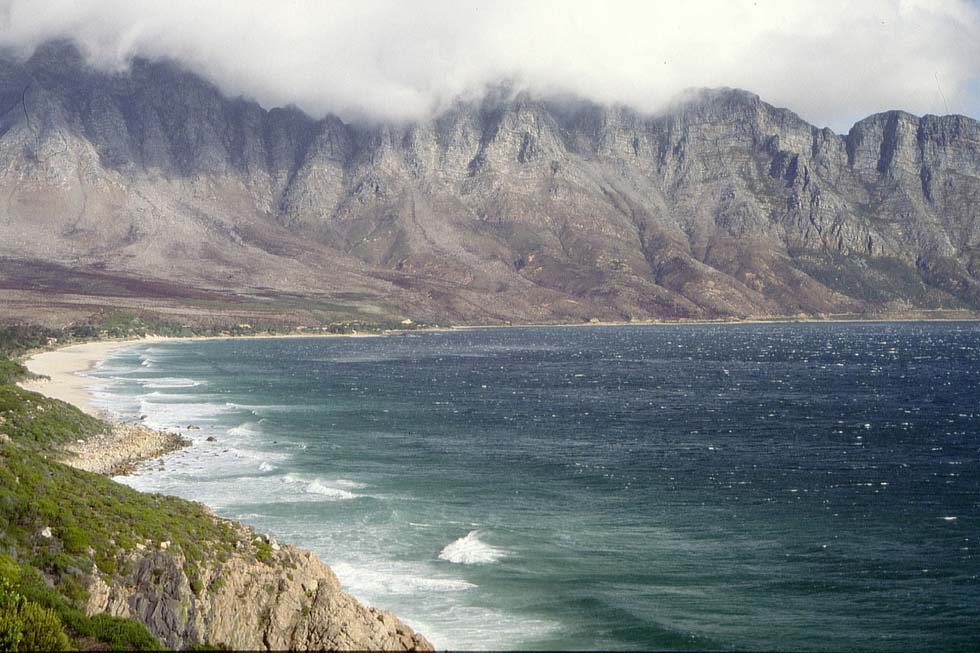
False Bay, South Africa (WS)
In the 19th century, the epoch of steam shipping, the history of Africa became characterized by the rivalry of European colonial powers. Already in the 17th century England and France had set up possessions on the West Coast, where during centuries black dealers had enslaved black people for sale. In 1787 England founded the Freetown settlement for liberated slaves. On the Cape, England displaced the Dutch East India Company in 1795. The British Empire kept the Cape Colony firmly after Napoleon's defeat in order to secure the India route. With discovery of gold on the Witwatersrand in 1885 and then with exploration of the diamond fields, the region of South Africa achieved greater economic importance than the West Coast. Cecil John Rhodes, Prime Minister of the Cape Colony from 1890 to 1895, dreamt of a British Empire stretching from the Cape to Cairo, symbolized by a Cape-to-Cairo railway (with an estimated traveling time Cape Town - London of 16 days hardly competitive with the much more comfortable ships). The Boer War raged between 1898 and 1902. In 1910 the Union of South Africa was founded. The South Atlantic continued to be the dominant way to South Africa, though the Suez Canal had been opened in 1869 (this secondary East Coast route is dealt with the chapter Branch Lines / Africa). A French dream of a colony extending from the Atlantic to the Indian Ocean ended when in 1898 British troops under Lord Kitchener re-conquered the Sudan, defeating the Mahdi. After the German emperor Wilhelm II had decided to build up a navy rivaling with the British, England concluded in 1904 the "Entente Cordiale" with France, thus securing the Empire for the next decades.
Elder Dempster Lines
The earliest English trade route to Africa was established by sailings to the West Coast. Not before the '30s of the 19th century however an expedition under the command of Macgregor Laird was sent by the African Inland Commercial Company to enter the Niger from the ocean with two small paddle steamers and a brig. The expedition proved a commercial failure and Laird turned towards his father's shipyard. In 1850 Freetown, Sierra Leone, had become an intermediate stop of the General Screw on the way to the Cape, but soon this detour was abandoned. On this reason Laird was awarded a contract for a subsidized steamer service to the West Coast. His African Steam Ship Company (known as 'The African') started with the small "Forerunner", which arrived at Freetown in October 1852, followed by "Faith", "Hope" and "Charity" with a few passenger accommodations, extending the service to Fernando Po.
A competitor, the British African Steam Navigation Co. or B&A, opened in 1869 services to West Africa with the "Bonny". The gambling to follow was described by Commander C.R. Vernon Gibbs (in 'British Passenger Liners of the Five Oceans'): "The B&A soon centralized their activities at Liverpool where they gave charge of their interests to Elder, Dempster & Co., founded by Alexander Elder and John Dempster (both previously in the employ of African's agents). African and B&A came to a working arrangement and after some years Elder Dempsters took over actual management of the B&A steamers. Elder and Dempster retired and left in control Alfred Jones who had begun running chartered vessels to West Africa on his own account ten years before (...). Under Jones the Elder Dempster firm, managers of the B&A, began buying 'African' shares and in 1891 Elder Dempster became managers of both West African lines". Sir Alfred Jones built up the first big British shipping group with Elder Dempster Lines, African, B&A, Beaver Line, Fyffes Line, C.M. Belge du Congo and a Canaries inter-island shipping firm. "The ambitious Imperial Direct West Indian Line was launched in the hope that it would prove a spearhead for capture of the West Indies mail contract from the Royal Mail S.P.Co., although these plans went awry" (so reported by Vernon Gibbs). After Jones death in 1909 his group was dissolved. Elder Dempster became a public company and in 1910 it passed under control by the Royal Mail Group. Other lines were of minor importance.
The ships of the Elder Dempster Group were of modest size, the "Benin" of 1884 being the first to surpass the 2,000 tons. The "Abosso" (1912/7,800 gt) and consorts were the largest before WWI. The hull was painted black, the single funnel yellow-buff, but B&A initially had a black funnel. The important mail route was Liverpool - Las Palmas - Bathurst (Banjul) - Freetown - Accra - Lagos and coastal steamers continued to Port Harcourt, Nigeria (see also 'The Trademakers', by Peter Davies). At Accra a special express train connected with the interior of Ghana (in 1928 Accra was substituted by the new port of Takoradi).
During World War I, Elder Dempsters suffered heavy losses, necessitating new tonnage. In 1921 the 7,937-ton "Aba" was introduced as world's first pure deep sea passenger motor-ship. She had been commissioned by the Tsarist government, completed for the Glen Line and rebuilt for B&A. She was followed by other diesel-powered ships, being the technology preferred by the Royal Mail Group.
The collapse of Lord Kylsant's Royal Mail empire in 1930 hit Elder Dempster hard. In 1932 a new company Elder Dempster Lines Ltd. was formed, the 'African' and B&A labels disappeared and from 1936 until 1943 the company was under Blue Funnel management.
After WWII, as a compensation for wartime losses, new diesel-powered mail liners were buit, the "Accra" (1947/11,599 gt), sister "Apapa" and the "Aureol" (1951/14,083 gt, 16 knots). The latter was a beautiful white ship with a buff-painted short funnel, being employed on the route Liverpool - Las Palmas - Freetown - Tema - Lagos - Apapa, on the return journey with a call at Takoradi. In 1972 Elder Dempster changed from Liverpool to Southampton. The company was engaged already years before in air transport and in 1974 the services of the "Aureol" were closed down. The liner was acquired by Latsis of Greece, who transferred the ship as the hulk "Marianna VI" to Jeddah and Rabegh. In 1989 a Greek tug brought her to Elefsina Bay near Athens, where she lay until she went to the scrapyard.
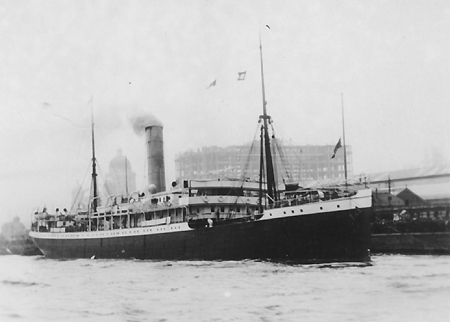
"Dakar", Elder Dempster Lines" (old card, coll. WS)
|
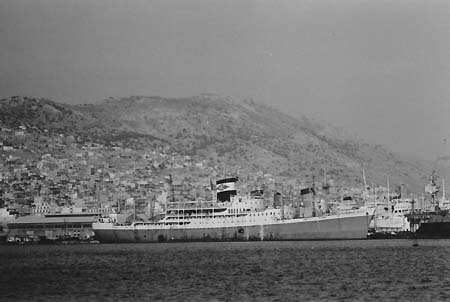
Four Cities class of Ellerman & Bucknall, as "Mediterranean Island" of Karageorgis, Perama 1974 (WS)
|
Via the Cape
In 1850 the first regular steamer services to Cape Town were inaugurated by the General Screw S.S.Co. The company was awarded a contract for conveying the Indian Mail on the route via the Cape, but like with the Australian Royal Mail S.N.Co. service, the attempt failed. The official Indian Mail took the way via Egypt even before completion of the Suez Canal (see chapter Indian Ocean), nevertheless various shipping lines mainly on the way to Australia called at Cape Town. A mysterious fate met the 9,339-ton "Waratah" of the Blue Anchor Line on the return voyage from Australia in 1909. On 26th July she left Durban, the sea was calm, the Captain had forty years experience. Next morning the ship was last seen off the South African coast - and then never again.
Union Line
The roots of the company which was to become the regular mail service provider to South Africa were described by Vernon Gibbs: "The Union Line began, Oct. 1853, with formation of the Union Steam Collier Co. (...) Arthur Anderson of the P.&O. was the Union Chairman (...). There can be no real doubt that, although independent, the Union Co. of Southampton was ancillary to the P.&O. (In 1857) the Admiralty invited tenders for a Cape steam mail service and the Union Co. submitted an offer which was accepted. The 530-ton "Dane" cleared Southampton on 15th September 1857 with mails and six passengers, and she anchored in Table Bay the afternoon of 29th October. The Union Steam Collier Co. had been re-constituted as the Union Steam Ship in previous December".
In 1863 a Cape Town - Durban coastal service was inaugurated. Access to the ports-of-call on that route was difficult on account of sandbars in the river mouths. Still for years debarking passengers were hoisted outboard in a wicker 'basket' and deposited on the deck of the waiting tug. In 1864 the service was extended to Mauritius and in 1866 to Galle, Ceylon, connecting with the P&O. It was closed down soon, but resumed to Port Elizabeth in 1876.
Other Companies
The Diamond Line, which had unsuccessfully tendered in 1862 for a mail contract, ceased operations in 1868. Another, the Cape of Good Hope Line, ran from 1867 to 1871. A third, the Cape & Natal started in late 1870. Other companies employing cargo steamers with some Saloon Class passengers were the Natal Direct of Bullard King Co., the Aberdeen Direct of Rennie & Son (then the Harrison Rennie Line) and the British & Colonial S.N.Co of Bucknall, in 1914 acquired by Ellerman Lines. Still in the 1960s the Ellerman & Bucknall Line provided London - Cape Town - Beira services with cargo-passenger motor-ships.
Castle Line
Donald Currie, engaged in the India trade with sailing ships, had to change to steam on account of opening of the Suez Canal. His brother managed the Leith, Hull & Hamburg Steam Packet Co, which chartered ships in 1872 to the expiring Cape & Natal, and Donald Currie assumed financial responsibility for their Cape voyages. In Oct. 1872 "Walmer Castle", commissioned for India services, was the first of Currie's own steamers to enter the Cape trade. As Currie's ships departed from London and were faster than the Union liners, the Cape Colony Government granted a subsidy for postage to Currie, whose enterprise was registered as the Castle Mail Packet Co. In 1879 Currie added a Mauritius service. From 1891 his ships had a call at Southampton, the port which was connected with London by the Union Line Express of the London & South Western Railway. At that time the twin-funnel flagships of the rivaling companies were the "Dunottar Castle" (1890/5,650 gt) and the "Scot" (1891/6,850 gt). The "Scot" of the Union Line reduced traveling time to 15 days. In 1905 however the money-losing beautiful liner, stretched to 7,800 tons, was sold to Hapag for employment as the cruise ship "Oceana".
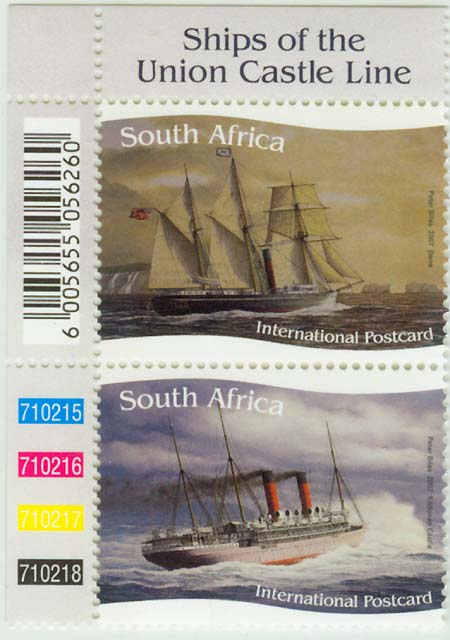
"Dane" and "Kildenon Castle", painted by Peter Bilas (South African stamps)
|
|
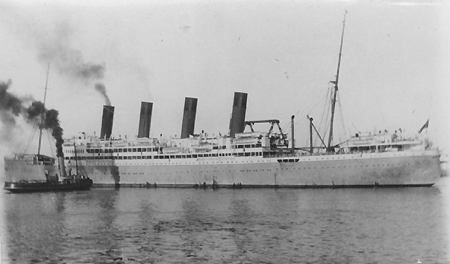
"Windsor Castle" of 1922, Union Castle Line (old card, coll. WS)
|
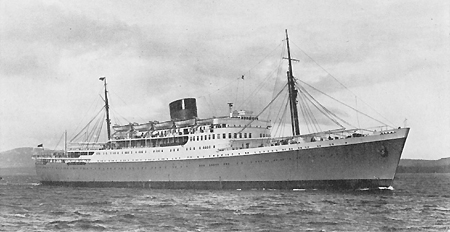
"Braemar Castle", Union-Castle Line (old card, coll. WS)
|
Union-Castle Line
There was a clause forbidding amalgamation of the rivaling companies, but finally they achieved to drop it by refusing separate bids. In March 1900 the Union-Castle Mail Steamship Company was constituted. Though the distinctive Castle colour scheme with black-topped red funnels replaced Union's yellow (initially black) funnels, it was an amalgamation, not a takeover. Every week a mail steamer for Cape Town left Southampton. An intermediate steamer for Durban, sometimes Lourenco Marques and Mauritius, with a call at Lisbon, departed from London. In 1910 a joint-service in conjunction with the British India S.N.Co, was started on a route London - Suez - Mombasa, then extended to Durban.
The mail liners of course were employed on the South Atlantic route to Cape Town. Before WWI the largest mail ships were the "Saxon" (1900/12,450 gt, 16 knots) and her rather similar five consorts, given 'Castle' names. With two sleek funnels they showed the characteristic style of the Union-Castle liners. During the Boer War several ships transported troops. In 1912 a substantial share of the company was acquired by the Royal Mail Group, without changing the renowned name and label.
Losses during WWI affected only minor ships. A remarkable fate had met the 6,750-ton "Galician". "On 15 Aug. 1914 Galician was intercepted and boarded south of Teneriffe by the liner-cruiser Kaiser Wilhelm den Grosse, but allowed to continue home on account of the women and children on board" reported Vernon Gibbs. Renamed "Glenart Castle" and clearly marked as a hospital ship, she was sunk in 1918 by a German submarine, causing headlines such as "Huns Sink Hospital Ship".
After WWI two liners of an entirely new design entered service. The 18,967-ton "Arundel Castle" was laid down in 1915, but introduced not before 1921. Like her sister "Windsor Castle" of 1922 she was fitted with 4 funnels, though two would have been sufficient. When in 1936 the speed had to be risen to 19 knots, the ships were re-engined with oil-fired furnaces, and two funnels replaced the four sleek ones. As the Royal Mail company was a pioneer in diesel propulsion, its subsidiary Union-Castle had to accept the new technology, too. The "Carnarvon Castle" (1926/20,063 gt) was their first diesel-powered mail liner, followed by the "Winchester Castle" and "Warwick Castle". The Royal Mail Group collapsed in 1930, but the Union-Castle line survived and the principle of diesel propulsion was not abandoned. A new category of fast motor-ships was introduced with the "Stirling Castle", her sister "Arundel Castle" (1963/25,550 gt each) and the "Capetown Castle" (1938/27,002 gt). Conceived for 19 knots, but capable of 21 knots, "Stirling Castle" achieved in 1936 a record, covering the 5,978 nm between Southampton and Cape Town within 13 days and 9 hours. The ships showed a new appearance with one single funnel, adapted also by the 20,000-tonners when they were re-engined. For a 'Round Africa' service, started already in 1922, the slower 15,007-ton motor-ships "Dunnottar Castle" and "Dunvegan Castle" were completed in 1936.
After World War II, in 1947, "Capetown Castle" undertook Union-Castle's post-war maiden voyage. With the "Pretoria Castle" and "Edinburgh Castle" (1948/28,700 gt each) the company went back to steam, with geared turbines driving two screws. "Pendennis Castle" (1959/28,582 gt), "Windsor Castle" (1962/32,697 gt), and "Transvaal Castle" (1962/32,697 gt), built for a speed of 21 knots, economic and modest compared to liners of other oceans, marked the final development. With the latter two ones, built by Cammel Laird resp. Brown, the long-term relationship with Harland & Wolff had ended. "Transvaal Castle" was equipped even with De Luxe suites, but all the 728 passengers shared the same public space, an innovation comparable to nowadays' cruise ships.
The Union-Castle Line came in 1956 into ownership of the British & Commonwealth Shipping Co., a holding. The Round-Africa route was reduced in 1962 to a London - Suez - Durban service, maintained for some years with the nice steamers "Rhodesia Castle" (1951/17,038 gt) and sister "Kenya Castle". More important, the Union Castle Mail Steamship Co. Ltd. provided Southampton - Las Palmas - Cape Town - Port Elizabeth - East London - Durban services still for years with the "Windsor Castle" "Pendennis Castle", "Edinburgh Castle" and the motor ship "Capetown Castle" of 1938. The "Transvaal Castle" was given away in 1966 to Safmarine of South Africa. The famous express train connecting Cape Town with Johannesburg and Pretoria was still running, only the name has been changed from Union Limited to Blue Train. In 1977 however the last mail passage England - Cape Town of the Union Castle Line was made with the "Kinpurnie Castle", a modest passenger-cargo vessel. The "Windsor Castle" had been sold in that year to Latsis, who rebuilt her into the floating hotel "Margarita L", positioned at Jeddah. In 2003 "The Mailship Windsor Castle Project" was presented with the intention of bringing her back to Southampton as a historic monument - in vain. In 2005 the ship went to Alang scrapyard. Finally also the traditional port of Cape Town was relocated and the old one became an attractive yacht harbour.
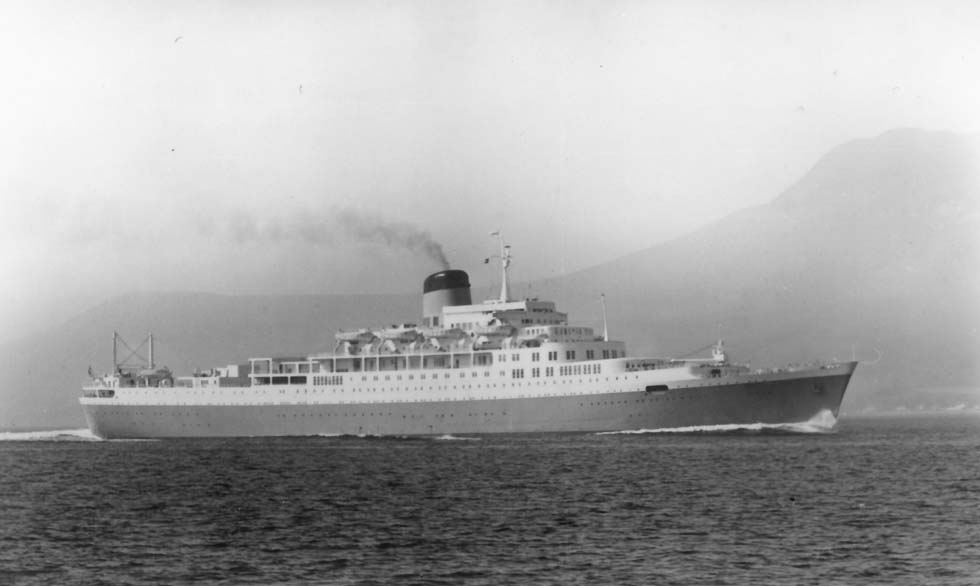
"Windsor Castle" of 1962 (archives Union-Castle)
South Africa
The Southern Steamships (Pty.) Ltd of Cape Town acquired in 1946 the former Hapag motor-ship "Orinoco" (confiscated in 1941 in Mexico), but further information is lacking (in 1947 she was employed on North Atlantic services by Nomikos of Greece, then sold to Transoceanica of Argentina). The government of South Africa created in 1946 the state-owned South Africa Marine Corporation, abbreviated Safmarine. As a partner of the States Marine Co. of the USA they started New York - Durban services in 1947. Though being a Commonwealth member, South Africa was excluded from providing services to England before 1949. In 1950 they were opened by Safmarine with the "Vergelegen" on a route from Birkenhead to South Africa. The enterprise must not be confused with the Springbok Line, which was founded in 1960 and sold its fleet after one year. In 1966 Safmarine took over the "Transvaal Castle" of the Union-Castle Line. The nice steamer, now registered with 30,212 tons, painted white and renamed "S.A. Vaal", continued Southampton - Cape Town services under British flag. She was joined by the "S.A. Oranje", ex "Pretoria Castle" (1948/28,625 gt, scrapped in 1987). The Union-Castle Line abandoned their traditional service in 1977 and in the same year also the "S.A. Vaal" of Safmarine was sold, continuing her career as "Festivale" of Carnival Cruise Lines.
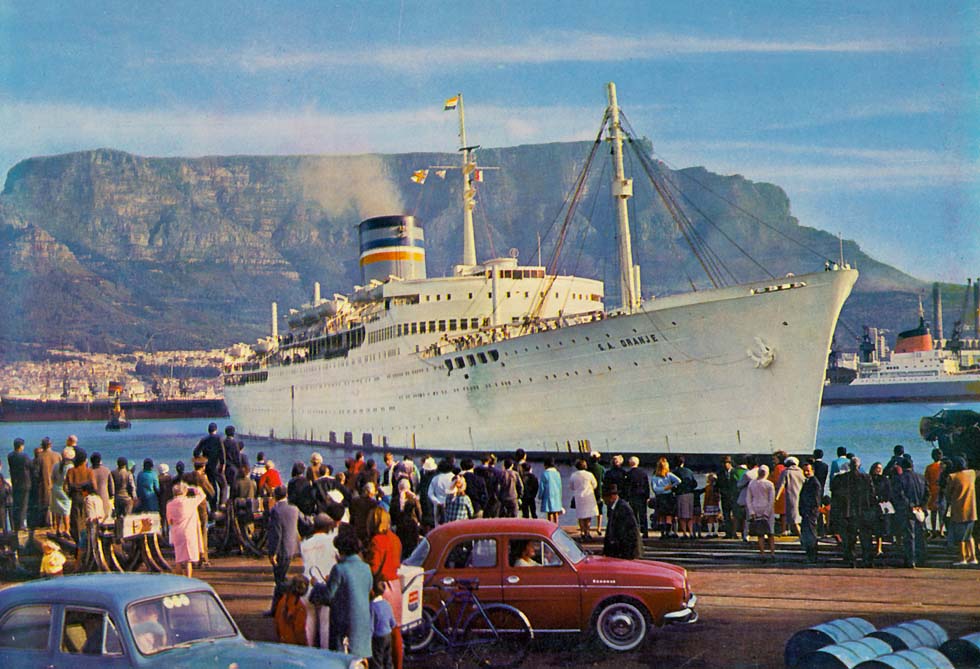
"S.A. Oranje", Safmarine, leaving Cape Town (old card, coll. WS)
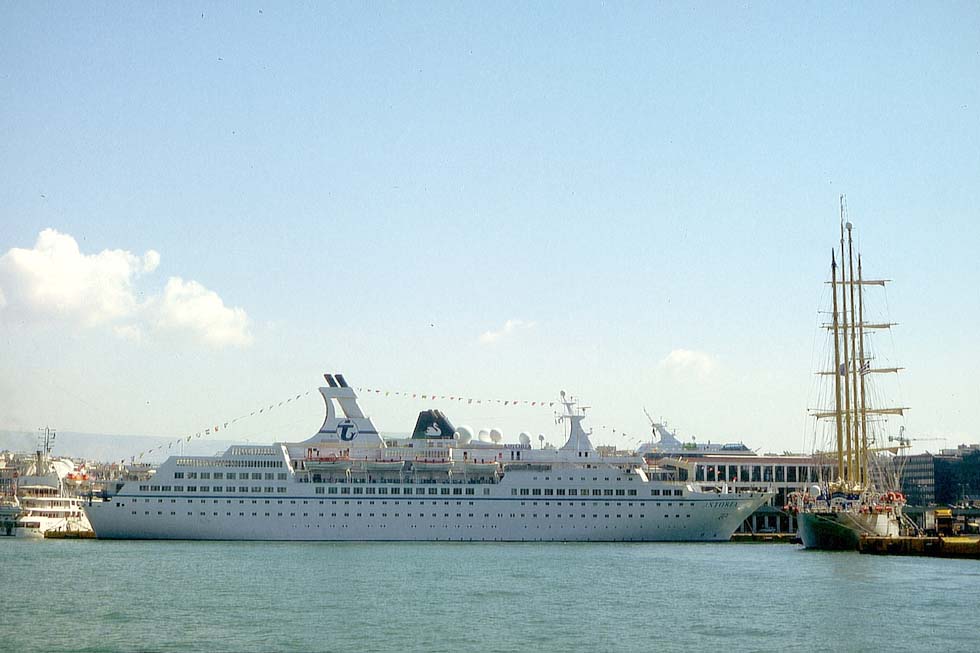
"Astoria", ex "Astor" of Hadag, Piraeus 2004 (WS)
In 1984 Safmarine bought the German cruise ship M.S. "Astor" (1981/18,835 gt) from Hadag Cruise Line and sent her on a maiden voyage Southampton - Cape Town. Unfortunately, the engines proved unsuitable for transoceanic liner services and a new ameliorated "Astor" was commissioned at HDW in Germany. In the meantime the first "Astor" was sold to Deutfracht of Eastern Germany to become the cruise ship "Arkona". As it appeared inconvenient for that Soviet-dependent state to buy a ship from the racist apartheid regime, the deal had to be made under the name of a Deutsch West-Afrika-Linie. The new 20,159-ton "Astor" was delivered in 1987, when Safmarine had already abandoned the Southampton - Durban service. Before completion the ship was sold in a bizarre way to Marlan Corp. of Panama to be marketed for cruising by Morgan Leisure of Colchester via a subsidiary Global Kreuzfahrten of Hamburg, both financially tied to Safmarine, to be registered with Mauritius for bareboat-charterer Irland Blyth, backed by a Hong Kong trading company (information by Kludas). Her confusing career continued when she became after not even two years the "Fedor Dostoevskiy" of the Soviet Union, immediately chartered by Transocean Tours of Bremen. The first and second "Astor", both with an unconventional funnel, survived until the 21st century as "Astoria" and "Astor" (see chapter Cruises/ German Tradition).
Other Attempts
After the traditional Union-Castle Line had abandoned the Cape Town services, the ABC Shipping Guide listed e.g. in 1978/79 only a service Durban - Cape Town - Southampton by Ulysses Line and TFC Tours of South Africa with the "Calypso", the former "Southern Cross" of Shaw, Savill & Albion. In 1980 however the ship was sold to a Panama-registered company as "Azure Seas".
About an attempt with the former French M.S. "Renaissance" of 1966, acquired by Epirotiki of Greece and chartered out to Costa, the magazine Ferries (4/2006) reported: "After her return in autumn 1983 the Greek had already arranged a new employment for the "World Renaissance": The Curnow Shipping Co. of Cornwall founded in cooperation with the South African tour operator TFC the Cape Albion Line, chartering the ship in order to revive the regular service Great Britain - South Africa, which had been abandoned by the Union Castle Line in 1977". The maiden voyage Plymouth - Cape Town was undertaken in Nov. 1983, then cruises to Mauritius were provided and in March 1984 the return voyage to Plymouth was started. However, there was a drinking water shortage, the crew menaced to abandon the ship at Las Palmas, the charter was cancelled and the passengers were flown home (after a confusing career the nice ship was to be seen at Piraeus still in the 21st century as "Blue Monarch").
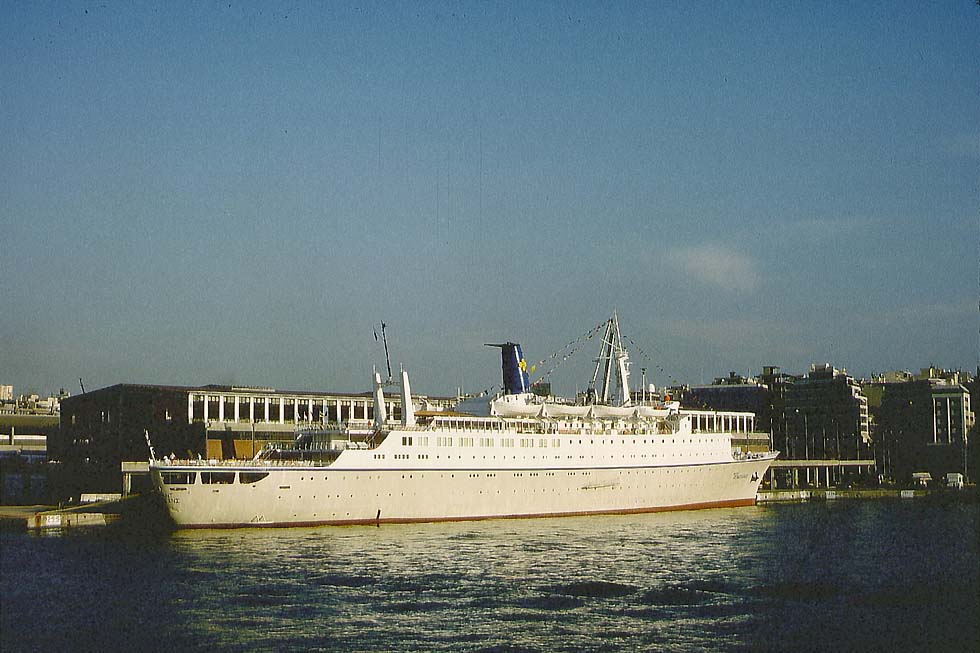
"World Renaissance" of Epirotiki, Piraeus 1989 (WS)
St. Helena
The remote British-owned island in the South Atlantic, where Napoleon had spent his last years as a 'pensioner' in exile, was connected during decades by intermediate services of the Union-Castle Line. After they were withdrawn in 1977, the St. Helena Shipping Co. , managed by Curnow Shipping, started in 1978 a subsidized mail service Avonmouth - Las Palmas - Ascension - St. Helena - Cape Town with the little "St. Helena" (ex "Northland Prince" of 1964). Requisitioned during the Falkland War in 1982, she was replaced only for some months by the "Aragonite" of only 522 tons, followed in the same year by the 8,262-ton "Centaur", built in 1964 for the Blue Funnel Line. Refurbished from a cattle-carrying combi vessel into a passenger-cargo ship, she got St. Helena's bottle-green funnel paint. In 1983 the charter was not renewed and the ship was sold to Shanghai Haixing for Shanghai - Hong Kong services. A new 6,767-ton passenger-cargo vessel "St. Helena" entered service in 1990. In the 21st century Cook's timetable listed still the Cape Town - St. Helena - Ascension - Cape Town service by SHS Andrew Weir Shipping. Twice yearly the service was extended to Portland, UK, and once yearly it connected even the remotest island in the South Atlantic, Tristan da Cunha. Ships Monthly (Jan. 2008) showed the "St. Helena" with a black hull, white superstructure and yellow funnel, and commented: "Her future hangs in the balance and 2008 may mark the last voyages to the UK", but Cook's timetable listed her also for 2010.
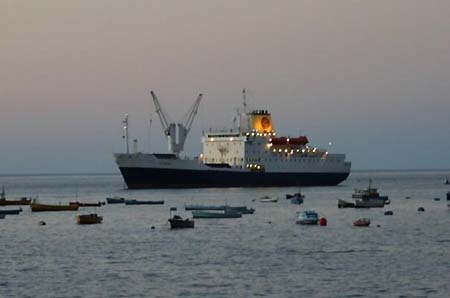 "St. Helena" in St. James Bay, St. Helena, Jan. 2005 (Burgh House, via Wikimedia)
"St. Helena" in St. James Bay, St. Helena, Jan. 2005 (Burgh House, via Wikimedia)
|